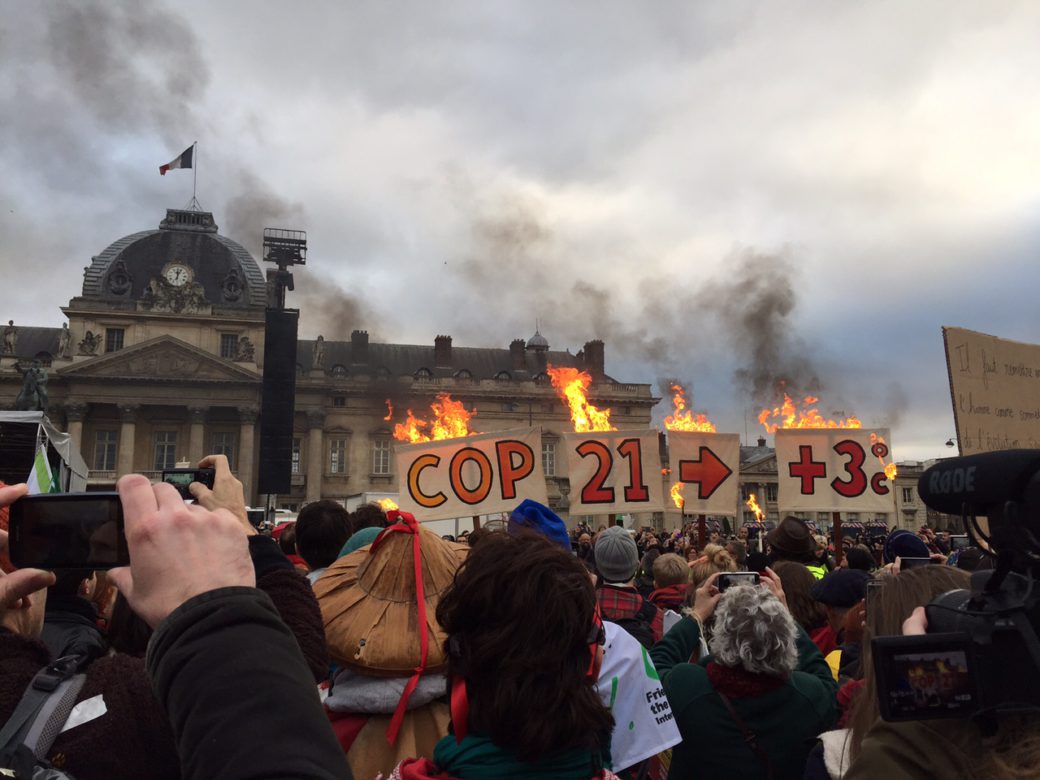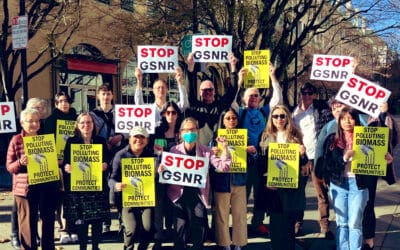
by Mary Louise Malig (Global Forest Coalition)
The Paris Agreement has been signed in New York with much fanfare, a lot of shaking hands and patting each other on the back, and claims that “we did it” – that is, agreed a historic climate agreement that would save the planet from climate chaos.
This week, government delegates and civil society are getting back to work in Bonn, in meetings of the Subsidiary Body for Implementation (SBI 44), the Subsidiary Body for Scientific and Technological Advice (SBSTA 44), and the new Ad Hoc Working Group on the Paris Agreement (APA 1). Their job is to hammer out practical next steps, including how to interpret what the Paris Agreement actually means and then how to implement it.
But in the aftermath of Paris, as the dust settles, what exactly is there to clap about? And what does it mean?
The Paris Agreement was certainly a great diplomatic success. The numbers alone sound rather impressive, with 194 countries adopting the agreement last December and 155 having signed the text by 23 March this year. This gives the impression that finally there will be serious action on tackling climate change.
But it was actually a grave defeat in terms of what it offers the future of humanity and the planet’s eco-systems.
For example, the text can sound impressive, especially when one reads that the aim of the Paris Agreement is to hold “the increase in the global average temperature to well below 2°C above pre-industrial levels and to pursue efforts to limit the temperature increase to 1.5°C above pre-industrial levels…” But this is just an aspiration. What counts is what countries meeting in Paris agreed to do, and that is another matter altogether.
In fact, most governments’ pledges to cut emissions (known as INDCs or Intended Nationally Determined Contributions) are so weak that it is estimated they will result in the planet warming by 3-4ºC, with dramatic consequences.
The text about adopting the Paris Agreement itself “Notes with concern that the estimated aggregate greenhouse gas emission levels in 2025 and 2030 resulting from the intended nationally determined contributions do not fall within least-cost 2˚C scenarios but rather lead to a projected level of 55 gigatonnes in 2030” (1) (that’s in contrast to the 40 gigatonnes that the resolution says should be the target).
This emissions gap is deadly and has very real consequences for all of us – species will disappear, extreme weather will devastate crops and livelihoods, and there will be whole islands lost, with climate refugees that have nowhere to go.
To add insult to injury, the pledges or INDCs that countries have made are not even legally binding. This means that if a country doesn’t fulfill its ‘contribution’ nothing will happen. There is no compliance mechanism or instrument to sanction that member state. Big polluters are supposed to cut emissions out of the goodness of their hearts, but experience shows us that this is not likely to happen, especially if it is seen as impeding economic growth.
Furthermore, while the Paris Agreement fails to create an effective mechanism to ensure that countries cut their emissions far enough and fast enough to close the emissions gap in time, it has opened the door for new carbon market mechanisms (in Article 6). So far carbon market mechanisms have done nothing to reduce emissions. Instead they have provided loopholes and ways for polluters to escape their historical responsibilities.
The way the text does this is rather subtle however. It does not use the terms ‘carbon markets’ or ‘carbon offsets’. Instead it speaks of a “mechanism to contribute to the mitigation of greenhouse gas emissions and support sustainable development” that will “contribute to the reduction of emission levels in the host Party, which will benefit from mitigation activities resulting in emission reductions that can also be used by another Party to fulfill its nationally determined contribution”. In other words, one country may buy carbon credits from another to minimise its obligation to reduce emissions. Spell that out clearly: carbon trading.
How this mechanism is going to operate, and which new carbon markets are going to be developed is yet to be decided. But the door is now open and it is very clear that large companies and financial investors want to include the carbon-absorbing activities of forests in carbon markets. The transnational corporations that have captured the climate change negotiations also want to have a carbon market related to ‘land use change’, a very vague term that could include anything from agriculture to livestock. This could be particularly dangerous as it could allow carbon accounting and carbon markets to determine food and agricultural policies.
Of forests, SDG 15.2 and plantations
Article 5 of the Paris Agreement speaks about forests. It talks about preserving them “through results-based payments” and “positive incentives for activities relating to reducing emissions from deforestation and forest degradation”. It also promotes the “enhancement of forest carbon stocks in developing countries” which implies the development of socially and environmentally damaging monoculture tree plantations, which can be included in carbon calculations under current rules. These activities are normally referred to as REDD+.
This article is far less ambitious than Sustainable Development Goal (SDG) 15.2, also recently agreed by governments, which aims to halt deforestation by 2020. This target does not get a mention in Article 5 of the climate agreement. Rather, in the INDCs submitted by countries with high rates of deforestation, we can see that they are planning to continue with deforestation not only after 2020, but even beyond 2030. For example, some INDCs, such as Brazil’s, mention a halt to illegal deforestation, but legal deforestation continues to be allowed.
A study done by a group of research centres analysed the commitments in the INDCs from the BRICS countries (ie Brazil, Russia, India, China and South Africa). It found that the overall outcome will be business continuing as usual until 2030. They will only begin reducing emissions by 2030. (2)
To summarise, the INDCs that are currently on the table are violating SDG 15.2, but this astonishing lack of policy coherence has not been acknowledged by the UN.
The Paris Agreement should have guaranteed the SDG goal of zero deforestation by 2020, so that it is coherent with these already agreed global goals. The reason it does not is that big business, which has undue influence in the climate change negotiations, does not want to stop the deforestation of real forests—it wants to be allowed to compensate for that deforestation with cash crop monoculture tree plantations. This is the road we are on now thanks to the Paris Agreement.
Finally the Paris Agreement does not speak explicitly about geoengineering or BECCS (Bioenergy with Carbon Capture and Storage)—but that does not mean these topics are not being discussed by governments. Since emissions cuts in the INDCs fall short of the ‘below 2ºC’ target, corporations have jumped on the opportunity to propose dangerous, untested and risky technologies which they argue would help reach it.
For example, ‘negative emissions’ is a euphemism for capturing carbon and carbon dioxide removal. Several studies, most recently by Biofuelwatch, have discounted the promises of BECCS, arguing that BECCS is not viable and at scale would even be a contributor to land use change emissions. (3) Furthermore, to implement large-scale monoculture tree plantations or bioenergy crops to capture and store carbon would need twice the world’s arable land area. (4)
Accepting the Paris Agreement uncritically risks us wasting another 15 vital years on distracting public opinion and creating the illusion that something positive is happening when, in reality, humanity and nature are losing precious time that can never be recovered.
After Paris it is clear that real solutions will come from the grassroots movements, Indigenous communities and people on the ground, and to encourage that process it is necessary to uncover the awful truth about what is really happening in the climate negotiations.
We need to call for concrete and urgent action that ensures that temperature increases stays below 1.5oC—without the use of risky and harmful technologies such as BECCS, and without loopholes, such as those relating to land use accounting and market mechanisms.
We need to fight for concrete action to reach the goal of zero deforestation by 2020, and resist the creation of new market mechanisms, especially on land use and agriculture. We must defend the rights of women, Indigenous communities, peasants and nature.
*Mary Louise Malig, a researcher and trade analyst, is Campaigns Coordinator of Global Forest Coalition.
(1) Resolution CP21 paragraph 17 http://unfccc.int/resource/docs/2015/cop21/eng/10a01.pdf
(2) Alice Amorim, Beatriz Mattos, Maureen Santos and Paula Morales, “INDCS of BRICS countries to the COP21” 2015
(3) Almuth Ernsting and Oliver Munnion, “Last-ditch climate option or wishful thinking? Bioenergy with Carbon Capture and Storage” 2015



